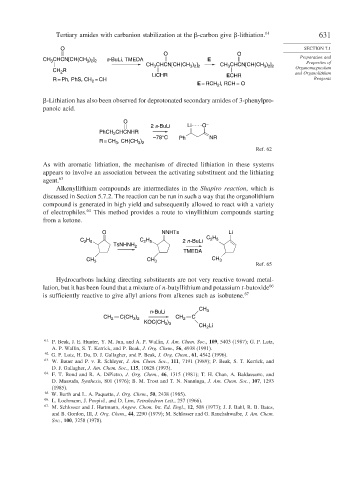Page 656 - Advanced Organic Chemistry Part B - Reactions & Synthesis
P. 656
Tertiary amides with carbanion stabilization at the
-carbon give
-lithiation. 61 631
O SECTION 7.1
O O
CH CHCN[CH(CH ) ] s-BuLi, TMEDA E Preparation and
3 2 2
3
Properties of
3 2 2
3
CH 3 CHCN[CH(CH ) ] CH CHCN[CH(CH ) ] Organomagnesium
3 2 2
CH 2 R
LiCHR ECHR and Organolithium
R = Ph, PhS, CH = CH Reagents
2
E = RCH I, RCH = O
2
-Lithiation has also been observed for deprotonated secondary amides of 3-phenylpro-
panoic acid.
O –
2 s-BuLi Li O
CHCNHR
PhCH 2
–78°C Ph NR
R = CH , CH(CH )
3
3 2
Ref. 62
As with aromatic lithiation, the mechanism of directed lithiation in these systems
appears to involve an association between the activating substituent and the lithiating
agent. 63
Alkenyllithium compounds are intermediates in the Shapiro reaction, which is
discussed in Section 5.7.2. The reaction can be run in such a way that the organolithium
compound is generated in high yield and subsequently allowed to react with a variety
of electrophiles. 64 This method provides a route to vinyllithium compounds starting
from a ketone.
O NNHTs Li
2 5
C H C H 2 n -BuLi C H
2 5
2 5
TsNHNH 2
TMEDA
CH 3 CH 3 CH 3
Ref. 65
Hydrocarbons lacking directing substituents are not very reactive toward metal-
lation, but it has been found that a mixture of n-butyllithium and potassium t-butoxide 66
is sufficiently reactive to give allyl anions from alkenes such as isobutene. 67
CH
n -BuLi 3
CH 2 C(CH ) CH 2 C
3 2
)
KOC(CH 3 3
CH Li
2
61
P. Beak, J. E. Hunter, Y. M. Jun, and A. P. Wallin, J. Am. Chem. Soc., 109, 5403 (1987); G. P. Lutz,
A. P. Wallin, S. T. Kerrick, and P. Beak, J. Org. Chem., 56, 4938 (1991).
62 G. P. Lutz, H. Du, D. J. Gallagher, and P. Beak, J. Org. Chem., 61, 4542 (1996).
63 W. Bauer and P. v. R. Schleyer, J. Am. Chem. Soc., 111, 7191 (1989); P. Beak, S. T. Kerrick, and
D. J. Gallagher, J. Am. Chem. Soc., 115, 10628 (1993).
64
F. T. Bond and R. A. DiPietro, J. Org. Chem., 46, 1315 (1981); T. H. Chan, A. Baldassarre, and
D. Massuda, Synthesis, 801 (1976); B. M. Trost and T. N. Nanninga, J. Am. Chem. Soc., 107, 1293
(1985).
65 W. Barth and L. A. Paquette, J. Org. Chem., 50, 2438 (1985).
66 L. Lochmann, J. Pospisil, and D. Lim, Tetrahedron Lett., 257 (1966).
67
M. Schlosser and J. Hartmann, Angew. Chem. Int. Ed. Engl., 12, 508 (1973); J. J. Bahl, R. B. Bates,
and B. Gordon, III, J. Org. Chem., 44, 2290 (1979); M. Schlosser and G. Rauchshwalbe, J. Am. Chem.
Soc., 100, 3258 (1978).

